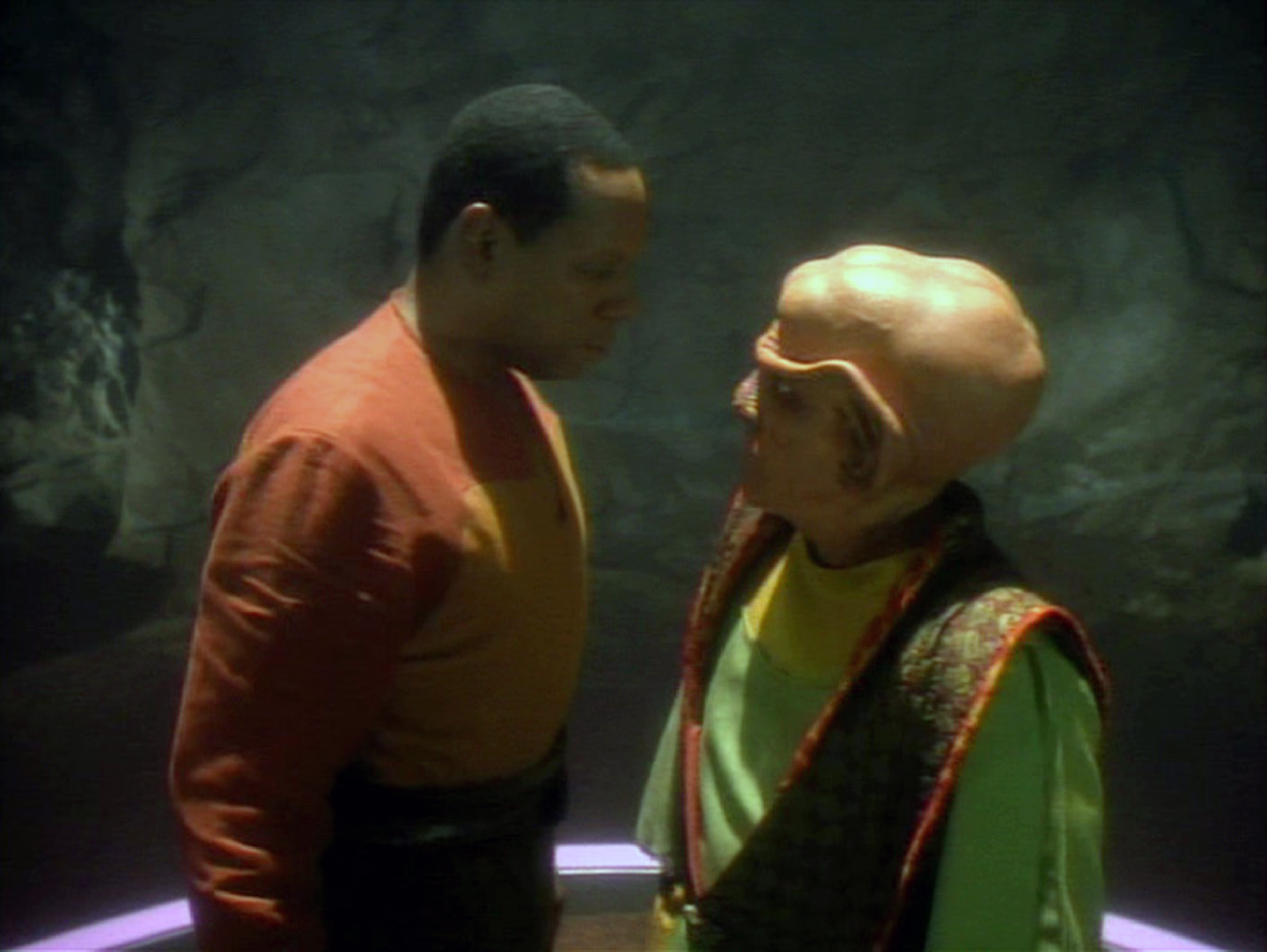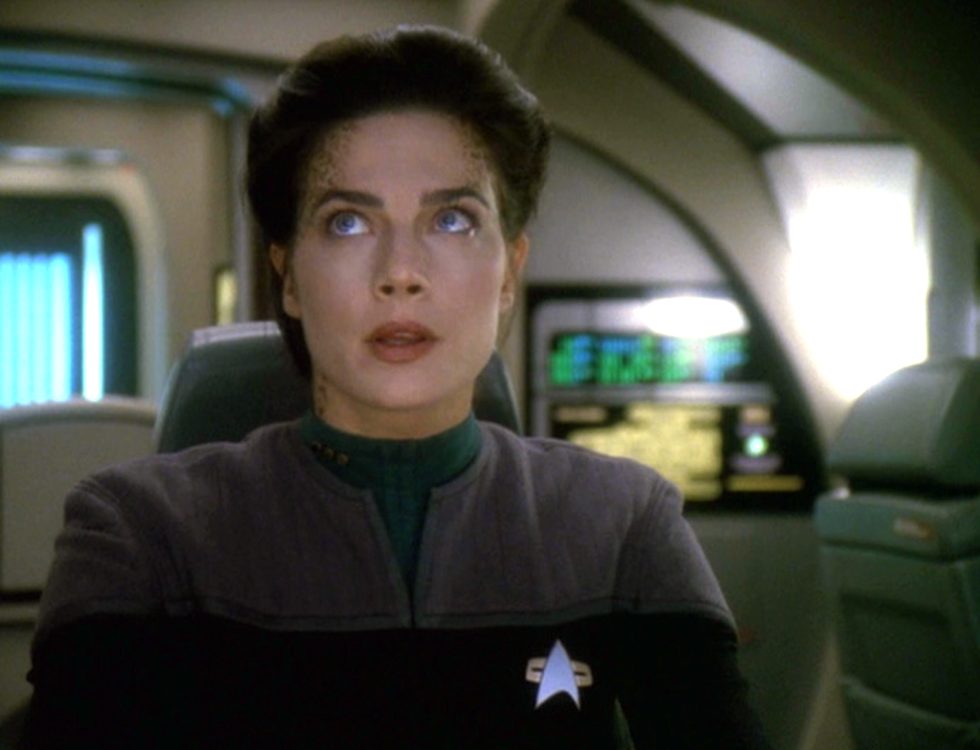
CBS / Getty Images
Deep Space Nine: The Trek spinoff that saved the day by staying put
You can’t get further from a global pandemic than a wormhole to the Gamma Quadrant.
by James CharismaAs millions binge-watch Netflix and coop up indoors, virus-inspired films such as Outbreak and Contagion, as well as television shows like The CW’s Containment, have found new audiences for those looking to tackle pandemic-related anxiety. After all, research seems to show that seeking out forms of entertainment that scare us—a method of confronting fears in a safe environment—can be a coping mechanism against perceived threats.
When thinking about the above criteria, however, one not-so-scary show comes to mind as a fitting series to retread: Star Trek: Deep Space Nine. That prompts a fair question: how does a '90s Star Trek spinoff about a space station in the 24th century relate to a coronavirus-driven pandemic in 2020?
Deep Space Nine turned the Star Trek paradigm upside-down when it debuted in 1993. Instead of going where no one has gone before, this show largely trapped its crew in a single place: aboard an isolated station located near the galaxy’s only stable wormhole, where any form of alien life—hopefully benign, though often scary and hostile—might suddenly appear and invade. Encountering never-before-seen threats was the norm, forcing the barebones senior staff and medical crew to solve problems they didn’t have either the skills or equipment for.
“Essential station operations”
While Trek series usually adopt a hopeful outlook on social and political issues, DS9 took a grittier approach, broaching decidedly tougher topics such as the fallout from a decades-long military occupation, racially motivated war crimes, and refugees escaping genocide. The station Deep Space Nine itself was created during a different kind of quarantine, built by slave labor during the Nazi-like occupation of the fictional planet Bajor by another alien species, the Cardassians. Because the characters couldn’t freely roam around to meet new people and find adventure, DS9 focused on developing narratives that were more inward-looking.
Just five episodes into the first season, a virus-causing fever and aphasia breaks out aboard the station, forcing the already anxious and frustrated new crew members to self-isolate in their quarters to slow the rate of infection. Despite the benefit of living in the technologically advanced 24th century (no need for takeout apps, thanks to food replicators), people on Deep Space Nine reacted how many people today have reacted to the emergency quarantine: by having big social gatherings.
“It looks like business as usual, but that’s impossible because all shops and businesses have been closed until further notice,” says Constable Odo (René Auberjonois), noticing a crowd at the bar owned by scheming saloon owner Quark (Armin Shimerman).
“Except, of course, for essential station operations,” Quark replies. “This quarantine has everybody on edge, constable. Would you deprive them of a little harmless diversion?” Later in the episode, while the virus is still at large, one ship pilot gets antsy and attempts to break quarantine by leaving the station, regardless of the risk it poses to unaffected populations on other worlds.
Sanctuary Districts, compared to the Tenderloin
The dehumanizing effects of humanity’s attempts to maintain order amid crisis is the central conflict in “Past Tense,” a two-part episode from DS9’s third season. Commander Benjamin Sisko (Avery Brooks) and Dr. Julian Bashir (Alexander Siddig) become trapped over 300 years in the past; specifically in San Francisco of 2024, when staggering economic inequality has led to the creation of walled-off “Sanctuary Districts” in cities across the United States. In the episode, what was originally intended to be temporary refuges providing free food, housing, and job placement opportunities for homeless Americans had degenerated into inhumane internment camps rife with violence. Sanctuary Districts quickly became overcrowded slums where social outcasts, the destitute, and mentally ill could be out of sight and out of mind for the rest of the country.
“Having seen a little of the 21st century, there is one thing I don’t understand,” Bashir says, after returning to the 24th century. “How could they have let things get so bad?”
As a comparison point: in the real 21st century, residents and business owners in San Francisco’s Tenderloin neighborhood filed a lawsuit in federal court earlier this month, demanding that the city take immediate action to clean up overcrowded streets and find housing for homeless residents after the number of tents and makeshift encampments in the area tripled amid the coronavirus pandemic. “We are set to be as aggressive as we can be,” promised new San Francisco Mayor London Breed in a press conference on May 6—where she unveiled a plan that included closing streets, moving people into a sanctioned encampment, and an increased police presence.

CBS / Getty Images
By DS9’s third season, a war is brewing between the United Federation of Planets (basically, the United Nations) and the Dominion, an alien empire from the other side of the wormhole, which includes a race of shape-shifting changelings that have the ability to impersonate anyone. This new threat forces characters to undergo mandatory, regular testing to make sure they haven't been replaced by changelings; their options are to have a vial of blood drawn or use a blade to slice open one’s palm. Testing for COVID-19, meanwhile, is arguably less intrusive, whether that means getting a 6-inch long Q-tip inserted in both nostrils to swab nasal cavities or using milder take-home kits. “I find this whole procedure offensive,” observes Cardassian Gul Dukat (Marc Alaimo) in one episode, as he opts for getting his blood drawn.
Unfortunate commonalities between DS9 and real life
Despite the increasing threat against Earth’s population by changelings in DS9’s fourth season, the Federation president dismisses Commander Sisko’s suggestions for screenings and security sweeps: “Precautions may be advisable, but I will not disrupt the lives of the population... For all we know, there was only one changeling on Earth, and he may not even be here anymore.” President Trump echoed similar sentiments in an interview on January 22 (“It’s one person coming in from China, and we have it under control”), one day after the first US case of coronavirus was announced in Washington state. Both in real life and DS9, sweeping policy changes were ultimately put into effect only after thousands had perished on Earth.
DS9 may have debuted in the early '90s, but it has uniquely become a show for right now, demonstrating that issues from biological testing to class (the Dominion’s societal hierarchy is determined by species) are as prevalent in the fictional 24th century as they are today. The show’s unique ability to look back on human history from “the future” offers a perspective that other pandemic-centered movies and shows available now simply can’t broach. DS9’s challenge: can we employ smart decision-making today to ensure that we’ll make it to tomorrow? “The question is,” Bashir wonders, after seeing the dismal conditions and tragedy in the aforementioned third-season episode, “how do we stop it from happening again?”